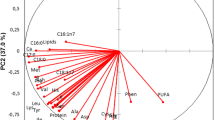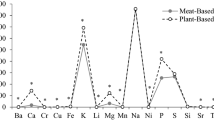Abstract
It has been reported that some wild green vegetables are good sources of α-linolenic acid (ALA, an essential omega-3 fatty acid). Using available data from the Norwegian food composition table, the present study shows that three common Nordic berries (blueberry, cloudberry and cowberry) on average contain 0.7 g of fat (=21% of total energy) and 0.25 g ALA (=36% of total fat) per 100 g, which is quite similar to what has been reported for the ALA-rich wild green vegetables. In addition, this study shows that a hypothetical replacement of 5% of Norwegian 8th grade girls’ diet, with a similar energy amount of wild berries, would significantly improve the diet – also improve intake of nutrients not commonly associated with berries.
This is a preview of subscription content, access via your institution
Access options
Subscribe to this journal
Receive 12 print issues and online access
$259.00 per year
only $21.58 per issue
Buy this article
- Purchase on Springer Link
- Instant access to full article PDF
Prices may be subject to local taxes which are calculated during checkout
Similar content being viewed by others
References
Crawford M, Galli C, Visioli F, Renaud S, Simopoulos AP, Spector AA (2000). Role of plant-derived omega-3 fatty acids in human nutrition. Ann Nutr Metab 44, 263–265.
Guil JL, Torija ME, Gimenez JJ, Rodriguez I (1996). Identification of fatty acids in edible wild plants by gas chromatography. J Chromatogr A 719, 229–235.
Halvorsen BL, Holte K, Myhrstad MC, Barikmo I, Hvattum E, Remberg SF et al. (2002). A systematic screening of total antioxidants in dietary plants. J Nutr 132, 461–471.
Malainey ME, Przybylski R, Sherriff BL (1999). The fatty acid composition of native food plants and animals of western Canada. J Archaeol Sci 26, 83–94.
National Nutrition Council Norwegian Food Safety Authority (1995). Food Composition Table. Universitetsforlaget: Oslo.
Nordic Council of Ministers (2003). The NORBAGREEN 2002 Study. Consumption of Vegetables, Potatoes, Fruit, Bread and Fish in the Nordic and Baltic Countries. Nordic Council of Ministers: Copenhagen.
Nordic Council of Ministers (2005). Nordic Nutrition Recommendations 2004. Nordic Council of Ministers: Copenhagen.
Øverby NC, Andersen LF (2002). UNGKOST 2000: Nation-wide Dietary Survey Among 4th and 8th Grade Pupils in Norway [Nor]. Directorate for Health and Social Affairs: Oslo.
Simopoulos AP (2002). The importance of the ratio of omega-6/omega-3 essential fatty acids. Biomed Pharmacother 56, 365–379.
Simopoulos AP (2004). Omega-3 fatty acids and antioxidants in edible wild plants. Biol Res 37, 263–277.
Simopoulos AP, Salem Jr N (1986). Purslane: a terrestrial source of omega-3 fatty acids. N Engl J Med 315, 833.
Zeghichi S, Kallithraka S, Simopoulos AP (2003). Nutritional composition of molokhia (Corchorus olitorius) and stamnagathi (Cichorium spinosum). World Rev Nutr Diet 91, 1–21.
Author information
Authors and Affiliations
Corresponding author
Rights and permissions
About this article
Cite this article
Bere, E. Wild berries: a good source of omega-3. Eur J Clin Nutr 61, 431–433 (2007). https://doi.org/10.1038/sj.ejcn.1602512
Received:
Revised:
Accepted:
Published:
Issue Date:
DOI: https://doi.org/10.1038/sj.ejcn.1602512
Keywords
This article is cited by
-
Berry meals and risk factors associated with metabolic syndrome
European Journal of Clinical Nutrition (2010)



